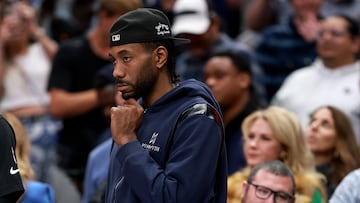What changes has the NBA made to the ‘load management’ rules?
With all the controversy that the topic has caused in recent years and most definitely last season, the NBA was always going to have to address the problem.

Whether it’s the notion of fans being robbed of the money they paid to see the stars of the league or the critiques from the icons of times gone by who believe modern players are soft, the end result is the same: Some of the biggest names are sitting out games and it’s not a good look.
Firstly, what is load management?
By now, most NBA fans and the players themselves - both past and present - are familiar with the term ‘load management,’ which in essence is the practice of monitoring and restricting a player’s physical activity to reduce the risk of injury. Where the term ‘load’ is concerned, this refers to the number of minutes, games, and indeed specific physical actions that may be asked of a player. Management of course refers to the way in which these aspects are regulated. This can entail the imposition of minute restrictions, starting or bringing a player off the bench or even having a player sit out a game altogether.
The last point is of course what has incurred the wrath of many fans, who have on occasion felt cheated when they are forced to miss out on seeing a player that they paid to see. Even former players have got in on the discussion, accusing teams of coddling players. No matter how you cut it, there are a few things that make the whole scenario a bit puzzling, to say the least. For starters, as much as we’ve given you a general idea of what the term means, there hasn’t appeared to be a set definition from team to team. Even more contentious, were the rules that were implemented by the league itself, which seemed to place optics ahead of the athletes’ health. That’s to say that the NBA started to hand out heavy fines to teams that were found guilty of sitting players during nationally televised games, OR for teams sitting multiple players at once. That of course has now changed with the league releasing a revamped set of rules.
So, the NBA made changes to load management rules?
Indeed it did. As mentioned above, the league never seemed to hit the mark entirely where the problem was concerned. In its initial attempt to address the issue, the number of back-to-back games on the schedule was limited, especially when it came to nationally televised matchups. This of course was an attempt to ensure that the star players were playing in the biggest games. As you can imagine, that didn’t quite work. This brings us to Wednesday’s vote by the league’s Board of Governors on the new player participation policy.
It’s understood that from now on, teams that are found guilty of the practice will receive significantly harsher fines and even more so if the game is nationally televised or an in-season tournament game. This will also extend to sitting multiple stars in a game or resting a star player for an extended period of time. These amendments will take effect from the start of the coming 2023-24 NBA regular season. Interestingly, where the term “star player” is concerned, the NBA has defined them in its new policy as those who have made an All-Star appearance or been selected to the All-NBA team in the past three seasons. There are currently 49 players who fit that description. Regarding the fines themselves, they are as follows:
- $100,000 for first violation
- $250,000 for a second violation
- $1 million more than the previous fine for any additional violation (i.e. $1.25 million for the third violation, $2.25 million for the fourth, etc.)
It’s worth noting, that not only can the NBA investigate a player’s availability, but an investigation will now be automatically triggered if a star player misses a national TV or in-season tournament game, multiple star players miss the same game or there are inconsistent public statements about a star player’s availability.
Are there any exceptions to the new NBA rules?
Yes, there are. Most notable of them is the idea that should a team contact the NBA at least one week prior to a back-to-back game, it can request approval of its decision to sit a star who is 35 years old or older on the opening night or one who has played 34,000 regular-season minutes or a combined 1,000 regular-season playoff games. Exceptions can also be made for a star who was previously injured. If you’re wondering, Mike Conley, Stephen Curry, DeMar DeRozan, Kevin Durant, James Harden, and LeBron James all qualify relative to the aforementioned criteria. While it would be fair to say that this is not a perfect system, it will be interesting to see how the league handles teams going forward, and of course how teams deal with the league’s way of handling them.








